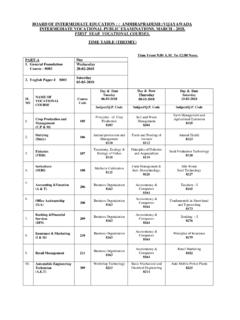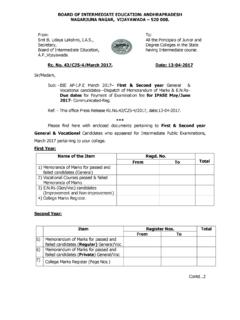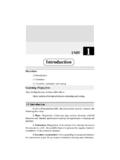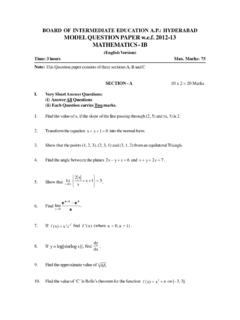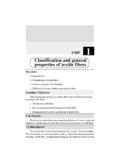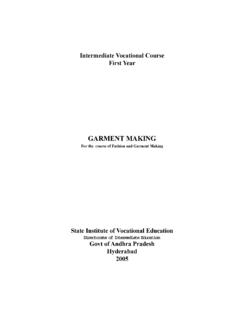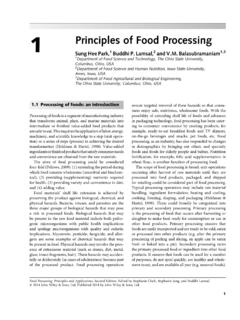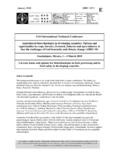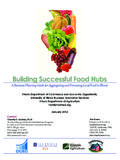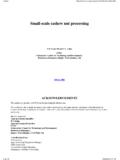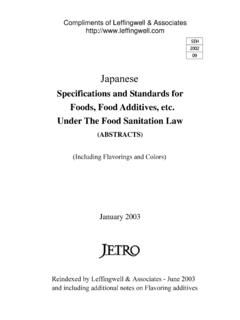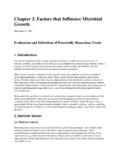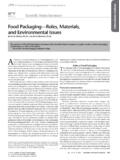Transcription of 3. FOOD PRESERVATION AND PROCESSING
1 3. food PRESERVATION AND PROCESSING . 1. INTRODUCTION. The main aim of food PRESERVATION is to minimize the growth of microorganisms during the storage period, thus promoting longer shelf life and reduced hazard from eating the food . Fruit and vegetables are an important supplement to the human diet ass they provide the essential minerals and vitamins and fibre required for maintaining health. For various reasons, this abundance of production is not fully utilized and about 25-30% of it is wasted due to spoilage. Most of fruits and vegetables are seasonal crops and perishable in nature. In a good season there may be a local glut, particularly of fruit, but because of insufficient transport facilities, lack of good roads and poor availability of packing materials, the surplus cannot be taken quickly enough to the natural markets in urban areas.
2 Moreover, the surplus often cannot be stored for sale in the off-season because of inadequate local cold storage facilities. Thus the cultivators do not get a good price for their produce because of the glut and some of it is spoiled resulting in complete loss. Two approaches are possible for solving this problem. One is the creation/expansion of cold storage facilities in the fruit and vegetable producing regions themselves, as also in the major urban consumption centres, to ensure supply of fresh fruits and vegetables throughout the year. Another approach is to process the fruits and vegetables into various products that could be preserved for a long time, and add to the value of the product. With increasing urbanization, rise in middleclass purchasing power, change in food habits and the dying out of the practice of making preserve in individual homes, dehydrated foods, pickles etc.
3 In the domestic market. Moreover, there is considerable demand for some of these products in foreign markets Mangoes both fresh and canned, fruit juices, salted cashew and good foreign exchanges. 2. OBJECTIVES. 1. To impart thorough knowledge on the technical skills in various aspects of food PROCESSING and PRESERVATION . 2. To inculcate the students to work in a hygienic way. 3. To provide an employment potential in food PROCESSING and PRESERVATION /self-employment. 3. SKILLS TO BE PROVIDED. 1. Handling of PRESERVATION equipment for large scale. 2. Working in hygienic manner. 3. Maintaining sanitation. 4. Preparation of preserved products 163. 5. Identification of spoilage and apply remedial measure. 4. EMPLOYMENT OPPORTUNITIES. 1. Wage Employment a. As A Technical Specialist In food Industry b.
4 Pickling Unit c. Bottling 2. Self Employment a. Establishing A Home Scale Unit Of food PRESERVATION b. Cottage Industry c. Small Scale Industry d. Large Scale Industry 5. Schemes Of Instruction Per Module Theory On Job Training Total Module Hours Weightage Hours Weightage Hours Weightage I 72 30 216 70 288 100. Total 72 30 216 70 288 100. Schemes Of Instruction Per Week Module Theory On the Job Training Total Modules I/II/III 6 Hours 18 Hours 24 Hours VOCATIONAL SHORT TERM CERTIFICATE COURS1E (ONE YEAR). IN. food PRESERVATION AND PROCESSING . SYLLABUS. Module I. food PROCESSING THEORY: Time: 72 Hrs Marks: 30. 1. food groups Time: 12 Hrs 164. Classification of foods Different food groups Nutrient contribution of different food groups 2. Cooking Time: 12 Hrs Composition of different foods Methods of cooking foods to conserve maximum nutrients.
5 Changes during cooking foods by different methods 3. PROCESSING of cereals, pulses, oilseeds, milk, meat etc. Time: 24 Hrs Cereals Types commonly used, its products, methods of cooking cereals, changes in composition during cooking, storage, antinutritional factors. By products from cereals, Nutritive value, composition, utilisation and uses. Pulses Difference between legumes and pulses. General milling And its advantages, methods of cooking legumes, changes in Nutritive value, antinutritional factors. By products from Pulses and Oil seeds, Nutritive values, composition, utilisation and uses. Spoilage of by products and factors affecting quality. Milk Composition, Nutritive value, types, objectives of milk PROCESSING , changes during boiling. Meat Composition, structure, cooking changes in composition and nutritive value, tenderizing agents, factors affecting.
6 Vegetables Classification, coloring and flavoring pigment changes that take place in cooking. Conservative methods of cooking vegetables, selection and storage. Fruits Classification, ripening changes, selection and storage. Common Products from by products Vinegar, fermented wines. Fermented Wines, types of wines, sources, raw material, steps in preparation, Aging, maturing, nutritive value and uses. By products obtained during production, PROCESSING of fruits and vegetables and utilisation. 5. food additives Definition and classification. Time: 10 Hrs Citric Acid Sources, preparation, uses. Permitted colors, flavors, stabilizer, emulsifier, antioxidants etc. Safety and need for use. Different additives used commonly in food , functions. 165. Stabilizers and emulsifiers and antioxidants need types and uses, specific roles with reference to each type.
7 Safety and its uses, BIS certification, Natural and artificial. 6. food standards FPO, MPO, Agmark, BIS Time: 4 Hrs Specification for different foods, food labeling . importance, specifications. 7. Effect of food PRESERVATION on nutritive value of Time: 10 Hrs food with special reference to vitamins, factors Affecting losses at various stages, means of minimizing losses. PROCESSING and PRESERVATION of foods its effect on nutrients . Vitamins and minerals. PRESERVATION of losses, means of minimizing losses at various Stages and factors affecting losses. Module I. ON THE JOB TRAINING Time: 216 Hrs Marks: 70. 1. Use of food additives in various cooking Time: 33 Hrs method leavening, flavor enhancing, emitters etc. 2. Preparation of wine. 3. Preparation of Vinegar. 4. Preparation of candied peel.
8 5. Preparation of products using oil seed cake. 6. Different fruit pectin and product preparation. 7. Preparation and labeling the products according to specification. Time: 20 Hrs 8. Visit to food industries to observe the application Time: 150 Hrs of food standards and food labeling 9. Visit to BIS Time: 13 Hrs Module II. food PRESERVATION THEORY Time: 72 Hrs Marks: 30. 1. Principals of food PRESERVATION Time: 8 Hrs Definition of food spoiling and food PRESERVATION , importance of food PRESERVATION . History and scope of fruit and vegetables industry, its growth and Development. food production and food loss incurred due to poor food Utilization. 166. 2. Methods of food PRESERVATION . Time: 8 Hrs Different methods used in the PRESERVATION of food high Concentration of sugar, pickling, dehydration etc.
9 Objectives Principles involved, merits and demerits. 3. PRESERVATION by low temperature. Time: 10 Hrs Methods involved in PRESERVATION of food by low temperature. Principals underlying the above methods. Quick and slow freezing merits and demerits. Thawing, refrigeration, cold storage, de-hydrofreezing, Cryogenic freezing etc. 4. PRESERVATION by high temperature. Time: 10 Hrs Definition of PROCESSING , canning, autoclaving PRESERVATION of food by canning, steps involved in process of canning. Spoiling of canned food . 5. PRESERVATION by preservatives. Time: 10 Hrs Objectives, principles, types of preservatives. Chemical preservative used in PRESERVATION of food , their Role and function, reaction. Different types of chemical preservatives. Safety in use and certification levels etc.
10 6. PRESERVATION by high osmotic pressure. Time: 8 Hrs Pickling, salting, curing principles. Methods, raw material, quality. Quality, PROCESSING . General spoilage. 7. PRESERVATION by dehydration Time: 8 Hrs Difference between sundrying and dehydration. Objectives and principles of dehydration. Steps in process of dehydration 167. Merits and demerits of dehydration. Effects on Nutritive value in dehydrated foods. 8. Containers used for storage Glass, tin, polythene Advantages and disadvantages. Time: 10 Hrs Different types of containers used in PROCESSING of foods. Selection of containers with specific reference to food . Types and advantages and disadvantages of using glass, tin, Polythene. Special food packaging modified atmosphere packing etc. Module II. ON THE JOB TRAINING Time: 216 Hrs Marks: 70.
